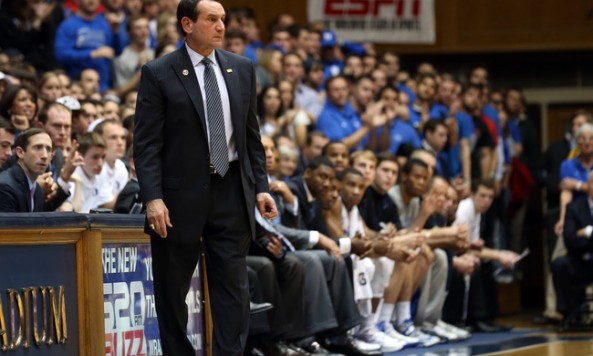Last season was a relatively disappointing one for the Duke Blue Devils. While they were good, they were not as good as we are used to expecting from Mike Krzyzewski’s teams. The Blue Devils failed to win 30 games for the first time in several years, still earned a two seed, but ended up losing in the first game of the NCAA tournament. The Duke offense was every bit as potent as usual, but the Duke defense was not up to par. Last season, according to the Ken Pomeroy ratings, the Blue Devil defense ranked No. 70 in the nation in adjusted defense. This was the first time since Pomeroy started his rankings that Duke finished outside of the top 20 in overall defense.
This season order has been restored, and the Blue Devil defense has again returned to the top 10. Coach K’s D is currently ranked No. 3 in adjusted defense. In Tuesday’s win over Clemson, the Duke defense held the Tigers to a soul-crushing 0.64 points per possession.
Duke’s defense was “down” last season for two reasons. First, Coach K’s team forced far fewer turnovers than what is typical for his teams. Duke ranked No. 251 last season in opponent turnover rate — a statistic where the Blue Devils have now returned to their typical spot in the top half of the NCAA. More importantly, this season Duke opponents are averaging an effective field goal percentage of 42 percent, which ranks No. 18 in the nation. Last season, the Blue Devils allowed an effective field goal percentage of 47 percent. A five percentage point decrease in effective field goal percentage is substantial, and accounts for a large portion of Duke’s defensive improvement. So what has changed?
The Blue Devil approach to defense has not changed for many years. Duke pressures the ball and extends their defense to deny passes. This extended defense has the effect of reducing opponent three point attempts, as there aren’t many good catch-and-shoot chances that come against Coach K’s squad. Last season, Duke opponents took a mere 24 percent of their shot attempts from three point range. This season, it is up slightly, to a still low 28 percent. While Duke cuts off the three point line, they do so while still preventing a lot of easy shots from in close. Last season, Blue Devil opponents attempted 35 percent of their shots at the rim. This total is down slightly, to 32 percent. This slight adjustment in shot distribution does not account for the large change in Duke’s defensive effectiveness.
Because the Blue Devils run opponents off the three point line, while still doing a decent job of protecting the rim, opponents typically take a high proportion of their shots as two point jump shots. This season, Duke opponents have taken 40 percent of their shots from mid-range, while last year opponents shot 41 percent of their field goals as two point jump shots. The big difference between this year and last year for the Blue Devil defense is this: last season, opponents hit 36 percent of their mid-range shots against Duke, while this season they have only made 26 percent of these shots. The Blue Devils have the fourth lowest opponent mid-range field goal percentage in Division I. Opponent three point shooting percentage is also down somewhat from last year to this one, having gone from 32 percent last season to 29 percent this season, but the biggest difference is that change in two point jump shots.
What is the big difference between this year and last? To lower opponent shooting percentage on two point jump shots, the Blue Devils are clearly contesting these shots more effectively, as illustrated by shot block percentages. This season, Krzyzewski’s group is blocking ten percent of opponent two point jump shots, as compared with six percent last season. But it is not just the shots that Duke is blocking that matter; opponent shooting percentages on unblocked two point Js are also down this season compared with last, going from 39 percent last season to 29 percent this year.
It is possible to dig deeper into this change between last season and this season by looking at opponent shooting in transition and half-court situations. On the initial shots of possessions, Duke opponents have made 21 percent of their two point jump shots in transition, compared with 50 percent a season ago. A 50 percent shooting percentage is a shockingly high total for two point jump shots. This is a large difference between this season and last, although it is one that occurs on a relatively small proportion of shots. In both this season and last, approximately 22 percent of initial opponent two point jumpers came in transition.
Duke opponents have also missed more often on two point jump shots taken in the half-court. Initial two point jump shots taken against the Duke half-court D have fallen 25 percent of the time, compared with 34 percent last season.
NCAA averages for two point jump shooting percentages on initial attempts is about 35 percent both in transition and half court situations. Last season, Duke suffered in transition against two point jump shots compared with the national average, while doing about average in half-court. This season, Blue Devil opponents are shooting a much lower than average shooting percentage on mid-range shots no matter when in the shot clock they attempt them.
So why have the Devils been so good against mid-range attempts this season? This is the point where we leave the realm of data, and enter the realm of speculation. It is a much less comfortable place. Some of this is probably random chance; when an opponent shoots 50 percent in transition jump shots, at least some bad luck is likely involved, and there wasn’t any reason to expect this would continue this season. Duke is also likely doing a better job of contesting these shots, as suggested by their shot blocking percentage improvement.























